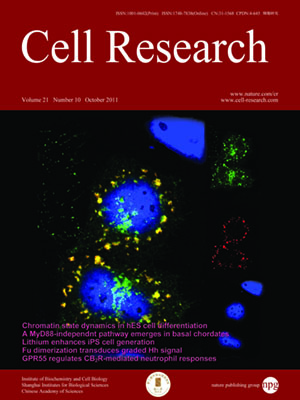Volume 21 Issue 10, October 2011: 1487-1508
ORIGINAL ARTICLES
HDAC2 phosphorylation-dependent Klf5 deacetylation and RARα acetylation induced by RAR agonist switch the transcription regulatory programs of p21 in VSMCs
Bin Zheng, Mei Han, Ya-nan Shu, Ying-jie Li, Sui-bing Miao, Xin-hua Zhang, Hui-jing Shi, Tian Zhang and Jin-kun Wen
Department of Biochemistry and Molecular Biology, Key Laboratory of Neural and Vascular Biology, Ministry of Education, Hebei Medical University, No. 361, Zhongshan East Road, Shijiazhuang 050017, China
Correspondence: Jin-kun Wen,(wjk@hebmu.edu.cn)
Abnormal proliferation of vascular smooth muscle cells (VSMCs) occurs in hypertension, atherosclerosis and restenosis after angioplasty, leading to pathophysiological vascular remodeling. As an important growth arrest gene,
p21 plays critical roles in vascular remodeling. Regulation of
p21 expression by retinoic acid receptor (RAR) and its ligand has important implications for control of pathological vascular remodeling. Nevertheless, the mechanism of RAR-mediated
p21 expression in VSMCs remains poorly understood. Here, we show that, under basal conditions, RARα forms a complex with histone deacetylase 2 (HDAC2) and Krüppel-like factor 5 (Klf5) at the
p21 promoter to inhibit its expression. Upon RARα agonist stimulation, HDAC2 is phosphorylated by CK2α. Phosphorylation of HDAC2, on the one hand, promotes its dissociation from RARα, thus allowing the liganded-RARα to interact with co-activators; on the other hand, it increases its interaction with Klf5, thus leading to deacetylation of Klf5. Deacetylation of Klf5 facilitates its dissociation from the
p21 promoter, relieving its repressive effect on the
p21 promoter. Interference with HDAC2 phosphorylation by either CK2α knockdown or the use of phosphorylation-deficient mutant of HDAC2 prevents the dissociation of Klf5 from the
p21 promoter and impairs RAR agonist-induced
p21 activation. Our results reveal a novel mechanism involving a phosphorylation-deacetylation cascade that functions to remove the basal repression complex from the
p21 promoter upon RAR agonist treatment, allowing for optimum agonist-induced
p21 expression.
Cell Research (2011) 21:1487-1508. doi:10.1038/cr.2011.34; published online 8 March 2011
FULL TEXT | PDF
Browse 2014


